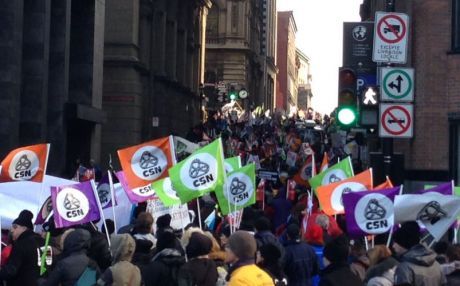News
You are here
Quebec general strike: “The most important strike since 1972”

December 10, 2015
On December 8, Jacques Letourneau, President of one of Quebec’s largest union federations, the CSN, said on Twitter: “Tomorrow’s general strike by the Common Front is the most important one since 1972.”
In May 1972, all of Quebec’s major trade union federations united in a “Common Front” and staged a month-long general strike, the largest strike in North American history at the time. It shook the foundations of Quebec society, and led to workers taking over radio stations and municipal government structures in nine cities and towns.
On December 9, 2015, nearly half a million Quebec workers staged a province-wide general strike: 400,000 who are members of a new “Common Front” of teachers, healthcare workers and government ministry workers, plus another 34,000 teachers in a separate union, the Fédération autonome de l'enseignement (FAE).
A march and demonstration of 150,000 clogged the streets of downtown Montreal that afternoon, with picket lines, marches and rallies in regions, cities, towns and villages throughout Quebec, including in Inuit communities in the Arctic. Quebec City also saw a large march and demo in front of the National Assembly, and FAE strikers camped out in front of the Education Ministry in Montreal.
This was the fourth in a series of one-day rotating strikes which took place region by region in Quebec, leading up to the province-wide escalation. In early fall, members of the Common Front and other unions voted to stage up to six days of rotating strike, so two more strike days are possible with the current strike mandate.
In fact, the FAE is already staging three consecutive days of strike: December 9, 10 and 11, in 800 primary and secondary schools across Quebec. Despite the disruption to students and parents, FAE President Sylvain Mallette says he is convinced that public opinion is still leaning towards the side of his members, who are fighting for sufficient resources in public schools. The government wants to increase class size and reduce the teaching ratio for students with special needs. The “human chains” that parents have been forming around Quebec public schools on a monthly basis throughout the fall have been a visible demonstration of the active side of this public support, and public sentiment against austerity and in favour of resistance to it is even wider.
The government has been trying to impose a wage freeze, or close to it, on public sector salaries that have been under downward pressure for 35 years. So far they have been trying to do so through negotiations, though there has been a looming fear the government will turn to a special law to enforce a freeze.
Strategy
The strikes and the enormous public support for them have been an important source of pressure. The Common Front did delay this strike and converted it to another one-day strike rather than the three-day province-wide general strike that was planned for December 1-3 when it seemed like progress was possible on the salary issue, but this did not occur.
However, the government did try to undercut the strike and sow division within the Common Front by offering progress and even settlements on non-salary issues specific to many of the different sectors, which have their own tables in addition to the central table. In the lead-up to the strike, more than 30 tentative agreements were actually signed at sectoral tables like those of the nurses (FIQ) and CEGEP teachers (FNEEQ)—causing Treasury Board President Martin Coiteux and Quebec Premier Phillipe Couillard to publicly question the relevance of the strike.
But there is no question: when pressure is working, that’s not the time to call it off. And it is at the central table where the key question of salaries is being negotiated.
When and if the remaining two days of strike in the Common Front’s mandate will occur is unknown at the time of writing, but what is clear is that the movement against austerity in Quebec continues to provide example and inspiration.
Section:










